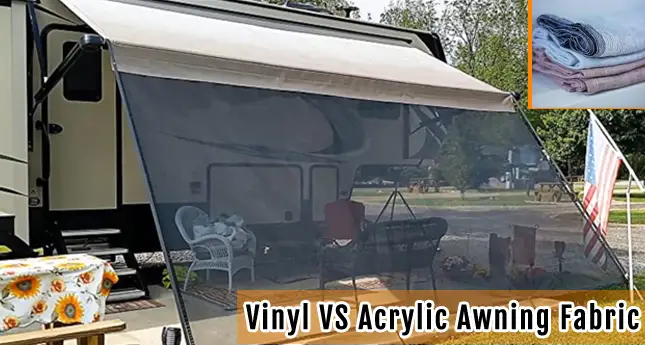Last Updated on April 15, 2023
Awnings are necessary when RV camping to protect you from the sun and rain. Having no awnings means constantly moving your RV to get shade. It’s time for you to buy a new RV awning, but you’re not sure whether to choose vinyl or acrylic.
While both are synthetic fabrics, they have different properties that make them more or less suitable for different purposes. You may end up with an awning that isn’t ideal if you lack knowledge of vinyl vs acrylic awning fabric.
This article compares the major differences between these two fabrics. After reading, you should have a much better idea of which one will be better for your needs.
Vinyl Vs Acrylic Awning Fabric: In-Depth Look

RV awning is a necessary accessory to your vehicle. It provides protection against harsh weather conditions, such as strong winds and rains. There are two main types of awning fabrics available on the market: vinyl and acrylic.
Each one has its own set of benefits and drawbacks. Let’s take an in-depth look at both of them:
Weight
One of the key differences between vinyl and acrylic awning fabrics is weight. Acrylic fabrics are typically lighter than vinyl, making them easier to handle during installation. On the other hand, vinyl is slightly heavier and more durable.
That extra weight can make it a better choice for windy conditions. But, it can also be a drawback if you need to move the awning frequently.
Breathability
A breathability factor should be considered before selecting an awning. After all, you don’t want your awning to trap heat and make your patio or deck feel like an oven.
Vinyl is a non-porous material, which means that it doesn’t allow air to pass through. As a result, vinyl awnings can make your outdoor space feel uncomfortably hot and stuffy.
In contrast, the acrylic fabric is very breathable. It allows air to circulate, making it an ideal choice for hot summer days.
Waterproofing
Another significant difference between these two materials is waterproofing. Vinyl is a naturally waterproof material, while acrylic is slightly water-resistant.
That means that vinyl awnings will keep you dry during a heavy rain shower. However, they may not stand up to heavy rains or strong winds.
As an alternative, acrylic awnings offer good protection against light rain. But they can stand strong winds because they are breathable.
Mold and Mildew Resistance

While both materials are resistant to any kind of moisture parasites like mold, mildew, etc. Where vinyl has a slight advantage over acrylic. That’s because mold and mildew need oxygen to grow, and vinyl has a nonporous surface that reduces airflow.
In this respect, acrylic is more vulnerable to both mold and mildew growth. But, it’s still resistant enough to protect your awning in most cases.
Color Fading
Out of all the possible concerns regarding awning fabrics, fading may be the least of your worries. That’s not to say it’s something to ignore, but both vinyl and acrylic awnings are resistant to color fading.
Vinyl is more resistant to UV rays, which means it will hold its color longer than acrylic. However, both materials are treated with UV-resistant chemicals, so you can expect them to maintain their color for several years.
You should choose vinyl awning fabric if you want the fabric to maintain its color over time. But if you don’t mind a little fading over time, then either material will work just fine.
Durability
In general, vinyl is a more durable material than acrylic. That’s because it’s less likely to tear, fade, or mildew over time. You can expect your vinyl awning to function for decades with proper care.
Acrylic is also a durable material, but it’s not as tough as vinyl. That means it may need to be replaced sooner if it’s exposed to harsh weather conditions or if it’s not properly maintained.
Aesthetics
When it comes to aesthetics, there’s no clear winner. That’s because both materials come in a variety of colors and styles. Vinyl awnings tend to have a more modern look, while acrylic awnings have a classic appearance. ultimately, the decision comes down to personal preference. Furthermore, the fabric you choose should complement the style of your home.
If you want an awning that will blend in with your home’s exterior, then choose a vinyl awning in a neutral color. But if you want your awning to make a statement, then go for an acrylic fabric in a bold or bright color.
Ease of Care
Finally, let’s talk about ease of care. Awnings made with vinyl or acrylic are easy to clean and maintain. But, vinyl is slightly easier to care for because it’s waterproof.
That means you can simply hose it down to remove dirt and debris. On the other hand, acrylic may require a little more effort to clean. You may need to use soap and water to remove stubborn dirt and stains.
These are just a few of the most important things to keep in mind when choosing an awning fabric. Ultimately, the right fabric for your needs will be determined by your individual circumstances. Consider all of the factors discussed here to make the best decision for your RV awning.
How Can You Replace the Fabric of an RV Awning?

Replacing an RV awning fabric is a relatively simple process. However, it’s important to follow the instructions in your owner’s manual to ensure that the job is done correctly.
Step 1: Remove the Old Fabric and Brackets
This can be done by gently pulling the fabric away from the awning roller tube. Once the fabric is free, remove the old brackets by unscrewing them from the awning rail. If the brackets are difficult to remove, you will likely need to use a screwdriver or pry bar to loosen them. With the old fabric and brackets removed, you’re now ready to install the new ones.
Step 2: Install the New Fabric
The first thing you’ll need to do is measure the fabric. Make sure to add a few inches on all sides so that you’ll have enough material to work with. Once you have the fabric cut to size, it’s time to start attaching it to the frame. Start by stapling the fabric to one of the crossbars.
Then, continue working your way down, making sure to pull the fabric taut as you go. When you reach the end, trim off any excess fabric and then secure it with another staple. Repeat this process on the other side and then sit back and enjoy your new RV awning.
Step 3: Enjoy Your New Awning
Now that the new fabric is installed, you can step back and enjoy your handiwork. It’s amazing how such a small change can make such a big difference in the overall look of your RV. Be sure to take some time to enjoy your new awning and all the compliments you’re sure to receive from admiring onlookers.
With just a little time and effort, you’ve given your RV a whole new lease on life. And who knows, maybe this simple project will inspire you to tackle some of those other long-neglected repairs. After all, there’s nothing like the satisfaction of taking care of your own home away from home.
Note: If you have a retractable awning, it may be necessary to replace the motor if it’s not working properly. This process is generally more involved, but it’s still relatively simple.
By following these steps, you can easily replace your RV awning fabric. Just be sure to consult your owner’s manual for specific instructions on how to remove and install your particular awning.
Frequently Asked Questions
There are a few questions that we get asked often about awning fabrics. Let’s see what they are.
1. What Are RV Awnings Made Of?
RV awnings are typically made from either vinyl or acrylic fabric. Both materials have their own benefits and drawbacks that you should take into account before purchasing an awning for your RV. Vinyl fabric is a water-resistant and durable material, while the acrylic fabric is light and breathable.
2. Can I Repair My RV Awning?
Yes, you can repair your RV awning. You will need to remove the awning from the RV to do so. Once you have removed the cover, you can lay it on a flat, clean surface to repair any tears or holes.
3. How Often Should I Replace My RV Awning?
According to experts, you are supposed to replace your RV awning at least once every five to seven years, based on how often you use it and how well you maintain it. If you live in an area with harsh weather conditions, you may need to replace your awning more frequently.
Conclusion
Now you know all about vinyl vs acrylic awning fabric. When choosing an awning for your RV, you’ll need to consider the climate, your budget, and your personal preferences.
Acrylic is breathable and UV-resistant, but vinyl is more durable and water-resistant. The right choice for you ultimately depends on your specific circumstances and needs. You can’t go wrong with either vinyl or acrylic, so just choose the fabric that’s right for you.
We hope you found this article helpful. And, be sure to check out our other articles about all things RVing.



